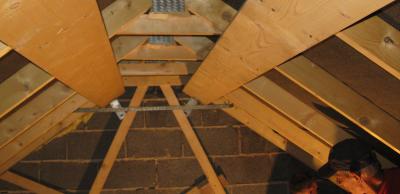Weatherproofing roofs: the basics
Increasingly extreme weather conditions mean we have to adapt our building practices to weatherproof our roofs by ensuring they stay in place in severe winds.
Changes in weather patterns have already led to a change in the wind loads used to calculate the fixings required for roof coverings.
Roof fixings
The suitability of fixings required to keep slates, roof tiles, ridge and hip tiles in place has been reviewed - basically the more fixings used, the more secure the roof. For example all single-lapped tiles should now be mechanically fixed (either a clip or a nail or a combination of both) and tiles at the perimeter must now have a minimum of two fixings.
Roof underlay
Just as important is the underlay. The latest BS 5534 standards use a new test method to determine the wind resistance of unsupported underlay. The test measures the upward deflection and potential movement of the required underlay drape when exposed to different air pressures as experienced in various regions across the UK.
The purpose of this test is to ensure the underlay can’t move to a point where it makes contact with and displaces roof tiles or slates. A new labelling system on the underlay has been introduced to help you determine which underlay is the most suitable for the area you’re working in and how best to install it.
Further guidance on the use of underlays in slating and tiling can be found in NFRC Technical Bulletin 06.
The best battens
Greater quality control of roofing battens is also needed together with a minimum depth of 25mm for spans up to 600mm. The best way to make sure you’re using the right battens is to buy them factory-graded to meet BS 5534. In addition to offering greater resistance to uplift they’re also stronger and thus safer during installation. Treated battens should always be used particularly around ventilation gaps.
Roof weatherproofing basics
- You can’t rely anymore on the mortar to hold roof components in place.
- All ridge and hip tiles should be mechanically fixed using clips, nails or screws.
- Contact the roof tile manufacturer for a full roof fixing specification for the area you’re building in.
- Avoid using small pieces of cut tiles at verges and abutments as they’re difficult to fix - use tile and-a-half tiles, half tiles or double-width tiles instead.
- Beware, reclaimed or recycled materials might not conform to the relevant standards.
- Roofing battens delivered to site should be graded and marked in accordance with the standard and have supporting documentation.
Further information
Involved in roofing? Find out about the new GetLead! app.
Please Note: Every care was taken to ensure the information was correct at the time of publication. Any written guidance provided does not replace the user’s professional judgement. It is the responsibility of the dutyholder or person carrying out the work to ensure compliance with relevant building regulations or applicable technical standards.
Sign up to the building bulletin newsletter
Over 48,000 construction professionals have already signed up for the LABC Building Bulletin.
Join them and receive useful tips, practical technical information and industry news by email once every 6 weeks.
Subscribe to the Building Bulletin




Comments
LIQUID ROOF COATINGS
Submitted 1 year 5 months ago
Do I need Building Regulations Approval for the coating?
LABC Response
Submitted 1 year 4 months ago
You will need approval if the performance of the new covering will be significantly different to that of the existing covering in the event of a fire. Further information can be found at Building Regulations: Work to an existing roof - Roof - Planning Portal - https://www.planningportal.co.uk/permission/common-projects/roof/building-regulations-work-to-an-existing-roof.
Best,
LABC Team
Add new comment